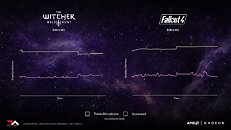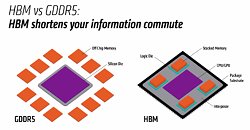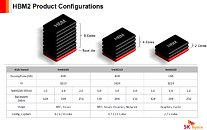Friday, March 31st 2017

AMD's RX Vega to Feature 4 GB and 8 GB Memory
It looks like AMD is confident enough on its HBC (High-Bandwidth Cache) and HBCC (High-Bandwidth Cache Controller) technology, and other assorted improvements to overall Vega memory management, to consider 4 GB as enough memory for high-performance gaming and applications. On a Beijing tech summit, AMD announced that its RX Vega cards (the highest performers in their next generation product stack, which features rebrands of their RX 400 line series of cards to th new RX 500) will come in at 4 GB and 8 GB HBM 2 (512 GB/s) memory amounts. The HBCC looks to ensure that we don't see a repeat of AMD's Fury X video card, which featured first generation HBM (High-Bandwidth memory), at the time limited to 4 GB stacks. But lacking extensive memory management improvements meant that the Fury X sometimes struggled on memory-heavy workloads.
If the company's Vega architecture deep dive is anything to go by, they may be right: remember that AMD put out a graph showing how the memory allocation is almost twice as big as the actual amount of memory used - and its here, with smarter, improved memory management and allocation, that AMD is looking to make do with only 4 GB of video memory (which is still more than enough for most games, mind you). This could be a turn of the screw moment for all that "more is always better" philosophy.
If the company's Vega architecture deep dive is anything to go by, they may be right: remember that AMD put out a graph showing how the memory allocation is almost twice as big as the actual amount of memory used - and its here, with smarter, improved memory management and allocation, that AMD is looking to make do with only 4 GB of video memory (which is still more than enough for most games, mind you). This could be a turn of the screw moment for all that "more is always better" philosophy.




52 Comments on AMD's RX Vega to Feature 4 GB and 8 GB Memory
EDIT:
I'm just wondering how they are doing it. How they prioritize what goes into on-board memory and what goes into system RAM. Is it game dependent or is it fully on-the-fly, do they have to make game profiles, this is the stuff I'm wondering the most about. Because if they can achieve this fully on-the-fly without any profiles, just a really intelligent algorithms (maybe assisted with driver updatable algorithms on software level) that could be really sweet. It could mean the end of obsessive stacking of insane amounts of memory on graphic cards and also give them more cost flexibility since they could focus more of the production cost on actual GPU instead of on VRAM memory modules. They aren't cheap, especially not in HBM2 flavor.
You have to think outside of box for Vega. The old "more memory on graphic card is better" doesn't apply here anymore because it's not following old methods or ways of doing it.
The fact that they still use 4 to 8GBs on these cards tells us that these card will be VRAM efficient.
The 4GB models will aim 1440p and the 8GB models will aim 4K since there is no need for more.
Gaming engines also are becoming more efficient in VRAM usage as well so im guessing that AMD will target VRAM limits on these cards to cut down on price, but give us 512bit bus and HBC + HBM Memory to be fast and efficient in modern AAA titles.
Im hoping for AMD to be better competitve so Nvidia will cut down on price and ALL FANBOYS TO BE HAPPY WITH BETTER AND CHEAPER GPUS.
Problem with texture streaming is that you're essentially doing a VRAM+HDD/VRAM+SSD instead of something a lot faster. And Vega's HBC with VRAM+RAM (+SSD) could certainly address that far better in same way how CPU addresses it's memory hierarchically. L1 cache is VRAM. L2 is RAM. L3 can be SSD. Because texture streaming still causes hitching, stuttering and framerate lag when doing texture streaming the way current game engines do it (VRAM+HDD) because it's parsing textures from really slow medium.
I know it was said that the increased number of layers per stack will allow them to release HBM2 products with 16GB and 32GB, but I never saw AMD promise that those capacities would be on consumer products.
However there would be no problem at all if the one meant to compete with the 1070 - 1080 did. With their new tech 4GB = 8GB. Literally.
I wouldn't be surprised if someone like SAPPHIRE released a toxic edition with 16GB of VRAM, but 8GB standard would be more than enough.
AMD claims to have new tech that allows for half as much memory to be used as normal. If that's true, then a 4GB model is more than viable. In fact I would say this kinda confirms that AMD is confident it will work. They wouldn't do it otherwise...
I've already bought the candles for the GTX 1080's first birthday.